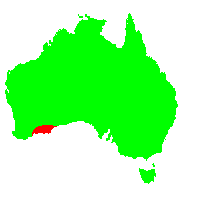General Description:
Banksia is a large genus of over 200 species in the Protea family, having been increased in size through the transfer of species in the former genus Dryandra to Banksia (see footnote box). The genus is almost exclusively Australian, being found in all States and Territories. A single species (B.dentata) is found in islands to Australia’s north as well as in tropical Australia.
Banksia obtusa is one of the prostrate species of the genus. It has horizontal stems which spread to about 1 – 2 metres and which may be partly underground. The leaves are long and narrow, being up to 30 cm long by 2 cm wide with blunt, triangular teeth along each side. The yellow flower heads form at the ends of the branches and are 3 to 5 cm in diameter. Flowers are seen in winter and spring and are surrounded by reddish/brown bracts.
B.obtusa is not commonly seen in cultivation but is one of the hardier species. It is likely to resent summer humidity but would be worth experimenting with in a range of well-drained soils and climates. It is reported to be slow growing and prefers full sun or partial shade. It should be tolerant of at least moderate frost.
Propagation from seed is relatively easy but cuttings are slow and difficult to strike.
A paper published in 2007 proposed that the genus Dryandra be subsumed into Banksia. This revised classification has been accepted by the Council of Heads of Australasian Herbaria and the new Banksia names now appear on Florabase (the website for the Western Australian Herbarium) and in the Australian Plant Census.
The new classification has come in for some criticism but, as the Austraian Plant Census has been adopted as the authority on plant names by ANPSA, the revised classication has been accepted on the ANPSA website. The previous Dryandra names will also be mentioned where appropriate. For further information refer to our Banksia page.

Banksia obtusa (syn. Dryandra obtusa)
Photo: Margaret Pieroni
Images of all species in the former genus Dryandra can be seen in the Dryandra Study Group’s Dryandra Image Gallery
 Australian Native Plants Society (Australia)
Australian Native Plants Society (Australia)